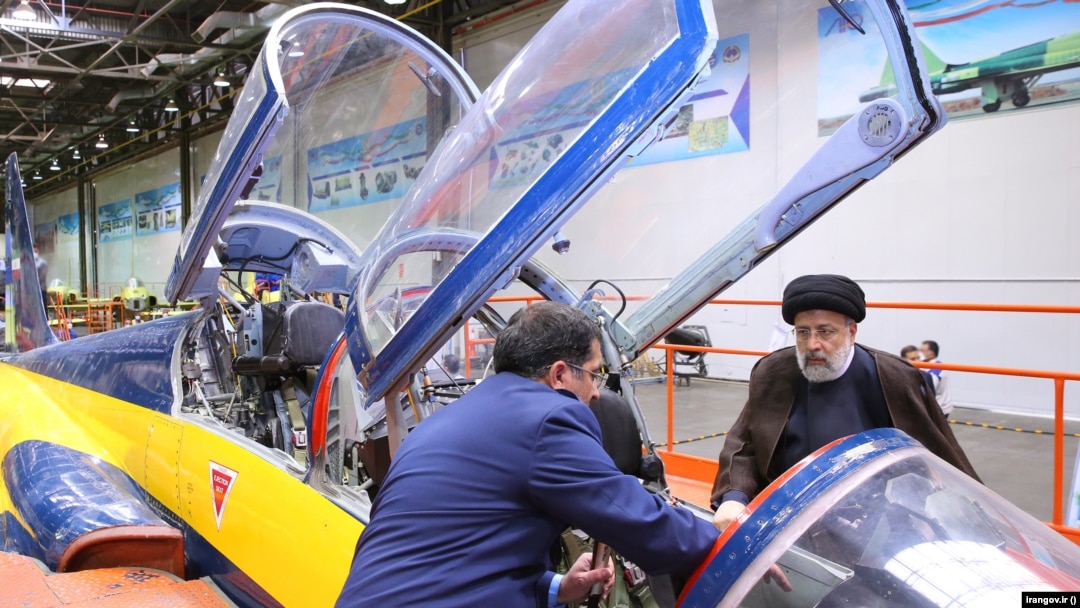The last time Iran attempted to produce its own passenger planes to upgrade its aging commercial fleet, the effort barely got off the ground before it was doomed by a series of deadly crashes.
Now, with nearly half of Iran's passenger aircraft grounded due to the lack of spare parts, the idea has taken flight again.
Iran’s Civil Aviation Organization announced earlier this year that it had reached agreement with the military to share expertise in the production of domestically manufactured commercial aircraft.
I'm very pessimistic.... Aircraft manufacturing is very, very expensive, consumes an extreme amount of capital, and requires a massive labor force, a technical labor force."-- Aviation expert Bijan Vasigh
A wide-body, turboprop-powered 100-seater is reportedly in the advanced planning stages. It has been touted by Iranian officials as the culmination of years of progress in gaining the engineering and manufacturing expertise needed to overcome U.S. sanctions that hinder Tehran's ability to obtain foreign aviation technology.
Little else is known about the national project, but it attracted global attention this month after President Ebrahim Raisi visited the Iran Aircraft Manufacturing Industrial Company (HESA) and was quoted by a lawmaker as having ordered eight of the new planes. But Raisi's office has since denied ordering any planes, and the country's past failures in producing its own passenger planes have raised skepticism that the new effort can succeed.
"I'm very pessimistic, considering the current technology and management and the state of the economy," said Bijan Vasigh, an aviation expert and professor at the U.S.-based Embry-Riddle Aeronautical University. "Aircraft manufacturing is very, very expensive, consumes an extreme amount of capital, and requires a massive labor force, a technical labor force."
Vasigh said the brain drain of engineers has limited Iran's design and manufacturing abilities, and that massive corruption within the domestic aviation industry has led to a lack of productivity. The idea that Iran could design and manufacture an aircraft starting from a clean sheet is "wishful thinking," Vasigh said.
More than half of Iran's passenger aircraft have been grounded due to age and the lack of spare parts and engines. U.S. sanctions imposed after the 1979 Islamic Revolution have hindered Tehran's ability to revamp the fleet with new planes and parts.
Some of the planes -- including U.S.-made Boeing 747 and McDonnell Douglas jets, and EU-made Airbuses -- are well past their expiration dates. Iran's ability to keep them in the air has impressed observers.
In the wake of the 2015 nuclear deal between Iran and world powers, U.S. sanctions were lifted and Iranian airlines placed orders for more than 300 planes, including modern airliners from Boeing and Airbus, and turboprop planes from European manufacturer ATR. But only three Airbuses and 11 ATRs were delivered to Iran before the United States withdrew from the nuclear deal in 2018 and began reimposing sanctions.
Tehran's subsequent interest in purchasing Chinese jetliners, which contain U.S. technology, went nowhere due to China's refusal to violate the sanctions. And reported efforts to look into purchasing Russia's Sukhoi Superjet apparently proved futile.
Only a handful of Iran's ill-fated Iran-140 passenger planes were actually built.
Iran's most ambitious effort to produce passenger planes on its own ended in 2014 when the domestically assembled Iran-140 was grounded by aviation authorities after a string of deadly crashes, and dozens of contracts were canceled.
The project to assemble the Iran-140 using kits provided by the Ukrainian aircraft manufacturer Antonov got off to a tragic start from Day One, when a prototype of the turboprop crashed into a mountain as it was carrying Ukrainian and Russian guests to celebrate the opening of a new assembly plant in Isfahan Province in 2002, killing dozens. While more than 100 Iran-140s had been ordered, only a handful were built, and their spectacular technological failures eventually led to them being grounded due to safety concerns.
One of the planes being tested by the domestic carrier Safiran Airlines suffered engine trouble in 2005 and was heavily damaged during an emergency landing. Safiran promptly returned the two other Iran-140s it was testing. In 2009, another Iran-140 crashed near the Shahin Shahr assembly facility during a training flight, killing all five crew members. And in 2014, tragedy struck again with the crash of an Iran-140 after it suffered an engine failure upon takeoff in Iran, leaving at least 38 dead.
Thirty-eight people were killed in the 2014 crash of an Iran-140.
The Iran-140 never recovered from its subsequent grounding by Iranian aviation authorities. While some are still operated by Iran's military and police, the effort to showcase Iran's technical and manufacturing ability is widely seen as a costly failure.
Since then, domestic manufacturer HESA has produced drones and helicopters for the Iranian military. In May, the company revealed a new turboprop transport plane, the Simorgh, that was hailed as a great national achievement that would boost the country's aviation industry.
Defense Minister Mohammad Reza Ashtiani said during the unveiling ceremony that the Simorgh, which is currently undergoing testing, would meet international standards and feature a modern propulsion system, fuselage, and other parts engineered and manufactured in Iran.
Aviation expert Vasigh says the amount of research and development that would be needed to design and manufacture an entirely new passenger plane, however, makes it highly unlikely that Iran could reach such a lofty objective.
Vasigh said he believes the new passenger plane will build off the Ukrainian-engineered Iran-140, and described the possibility that the planes would be delivered as "really unlikely."


